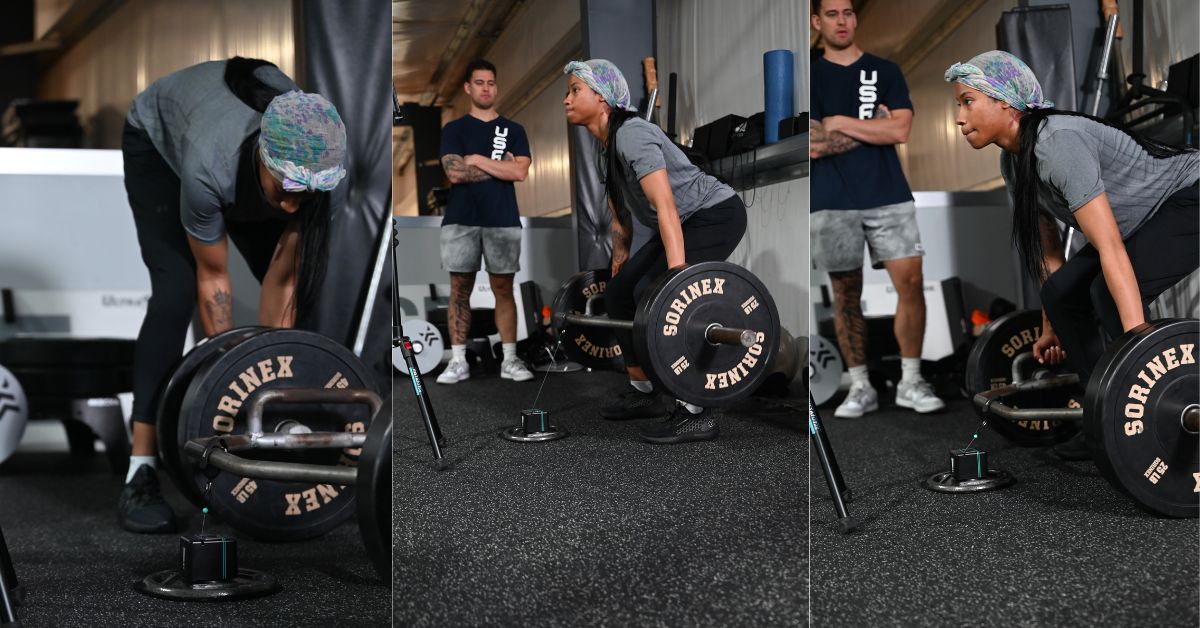By now, we all understand the mistake in the phrase “injury prevention” training, but we also understand the concept and its well-intentioned origin. We definitely, absolutely, positively can NOT train to 100% prevent sports injuries—not playing sports is the only way to prevent sports injuries.
What we CAN do is utilize the technology and advances in coaching to help our athletes reduce certain risk factors that are controllable variables in injuries. Qualities like movement fluency, fatigue, training volume, proper use of equipment, and work capacity are all things that coaches can influence and help athletes optimize, which, in turn, reduces the risk of certain injuries.
IFTTT means if this, then that. It’s a term used in software that refers to the connecting of multiple apps and platforms to automate chain reactions. If this happens, then trigger that, that, and that to happen automatically.
This is how I view the concept of using training to reduce injury risk. Choose concepts and programming that serve an initial purpose but also lead to these automated chain reactions.
I firmly believe VBT can play a significant role in mitigating risk factors that could lead to common basketball injuries such as ankle sprains, tendonitis, and muscle strains, says @JustinOchoa317. Share on XThis is where velocity-based training (VBT) comes into play, and I firmly believe that VBT can play a significant role in mitigating risk factors. Again, not eliminating injury—not even reducing injury. Simply decreasing risk factors that could lead to common basketball injuries such as ankle sprains, tendonitis, and muscle strains.
Common Basketball Injuries
Sprains, strains, tendonitis, and tendinopathy are the most common basketball injuries at every level. We often focus on the tragic injuries, such as ligament tears, tendon ruptures, or broken bones, but those don’t happen at as high of a rate as the former. It’s just what we hear about in the headlines.
In every basketball locker room, there will pretty much always be an athlete battling at least one of those nagging injuries.
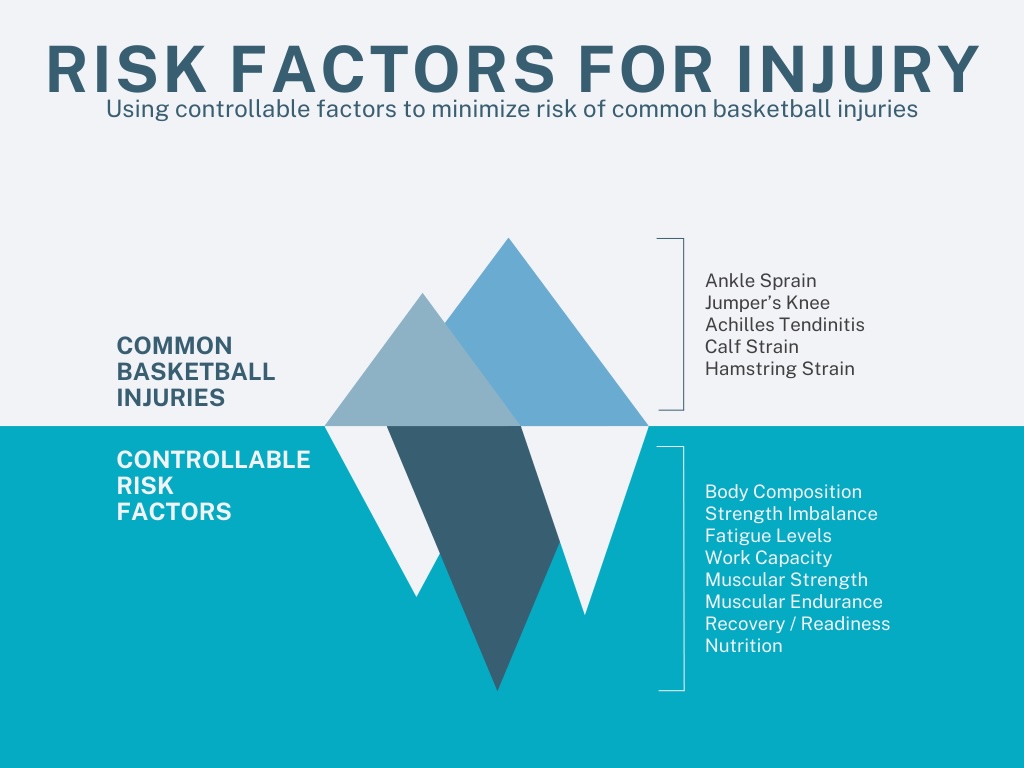
Ankle Sprains
The most common example is an ankle sprain. Death, taxes, and hoopers spraining an ankle are the guarantees in life. Can you prevent them? No. Are there controllable risk factors? Yes.
Uncontrollable factors would be the dreaded “coming down on someone’s foot” ankle sprain. You can chalk those up to bad luck.
Other common sprains, whether from a sharp cut or a simple move they’ve done thousands of times, can be the most mysterious and frustrating injuries for basketball players. Many times, we can tighten up the laces and use adrenaline to get through the pain, but some sprains just point blank take us out, and there’s no looking back from there.
As it relates to training, one of the biggest controllable risk factors of ankle sprains is actually body composition. Research shows that we should place emphasis on ensuring that athletes have and maintain the appropriate body composition.
As it relates to training, one of the biggest controllable risk factors of ankle sprains is actually body composition, says @JustinOchoa317. Share on XThis may seem obvious in the world of football, where some of the athletes are strategically “overweight” or play a position that involves one-on-one combat every single rep, but it’s also valid for basketball players.
Body composition is very strongly related to conditioning, and conditioning is very strongly related to fatigue levels. We’ll talk about fatigue and its influence on injury throughout this article, but an athlete’s body composition will represent their playing weight, too.
On many basketball frames, an extra 10 pounds can really bring a lot of unwanted load and force into some of the cuts, plants, and landings that happen thousands of times throughout the season. If the athlete is not structurally capable of withstanding those forces, that could start to take a toll on joint and tissue health.
Two other major risk factors are an imbalance in ankle flexor strength and poor dynamic balance.
And lastly, fatigue. Fatigue—which is a common denominator in all injuries—is an important risk factor because of the domino effect it can have on other functions, such as proprioception, muscle activation, and neuromuscular response time.
Tendonitis/Tendinopathy
In the realm of tendon injuries, basketball players commonly suffer from tendonitis or tendinopathy in either the Achilles or patellar tendon.
When hoopers do too much too soon, that painful tenderness below the kneecap is a major sign of Jumper’s Knee. Usually, we see cases of this at the high school level after holiday breaks due to a rapid decrease in activity followed by a rapid increase in activity. At the more advanced levels, it can be more of an overuse injury that has a few additional factors at play.
Like ankle sprains, body composition is an important risk factor for both Achilles and patellar tendon dysfunction. The main culprit to these injuries, though, is a rapid increase or spike in loading that overwhelms the current capacity of the tendon or region of the body.
This is why you can all but guarantee seeing a few of these issues pop up during training camp or early in the pre-season. If an athlete did not adequately prepare for the game’s demands, that load tolerance imbalance will undoubtedly flare up as Achilles tendonitis or patellar tendon pain.
Muscle Strains
When it comes to muscle strains, the calves and hamstrings are the common areas of the body that basketball players will injure. As mentioned before, fatigue, body composition, and increased loading are key risk factors of muscle strains. Muscle strength is also a key factor. As the famous Westside Barbell saying goes, “Weak things break.”
And no, a basketball player doesn’t need to be as strong as a Westside Barbell powerlifter. Actually, I would highly advise against aiming for those levels of strength, but having a respectable level of relative strength will provide a resiliency and robustness to the athlete that can truly impact their longevity.
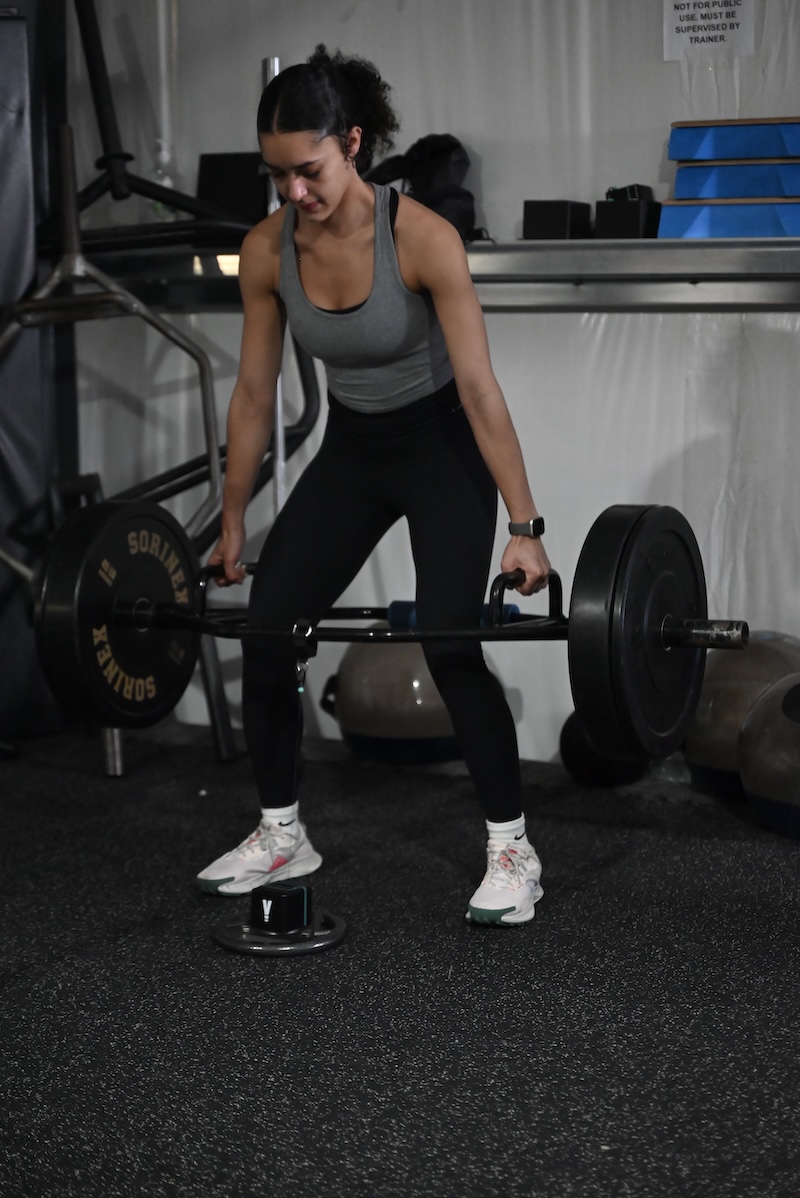
Strained muscles can be scary for basketball players because they are so sharp and immediate—the injury can feel like something much worse in the moment. We see this all the time—especially at the pro level—where there is an element of showmanship as well. A player goes down after an awkward move, and the crowd goes dead silent.
Fans, coaches, and teammates all base their assumptions on the player’s reaction…and it looks as if their career may have just ended.
The player limps off the court on their own strength, goes back to the locker room for 12 minutes, then comes back out and finishes the game with a triple double.
That illustrates the immediate pain, panic, and severity of a muscle strain acutely—and it’s even worse when it becomes a chronic injury or a recurring one. Many of these risk factors go hand-in-hand and layer with each other. These risk factors all overlap, and the kicker is that the No. 1 risk factor in ALL of these injuries is having a previous injury.
The kicker is that the #1 risk factor in ALL of these injuries is having a previous injury, says @JustinOchoa317. Share on XSo, a previous sprained ankle is a risk factor for calf muscle strain. And a prior calf muscle injury is a risk factor for an Achilles injury.
So, what do we do? Try to keep these risk factors minimized by all means. And we can try to quantify these efforts by using VBT.
Using VBT to Minimize Risk Factors
You can use velocity-based training for a lot of things in sports performance training, but at its core, I simply look at it as a quantification system. VBT quantifies movement velocity during training, which allows coaches to leverage real-time data to make informed decisions on load, volume, exercise selection, and intensity in an adaptive manner.
VBT systems like Vitruve can be implemented into any program and immediately make a positive impact because they give coaches objective information.
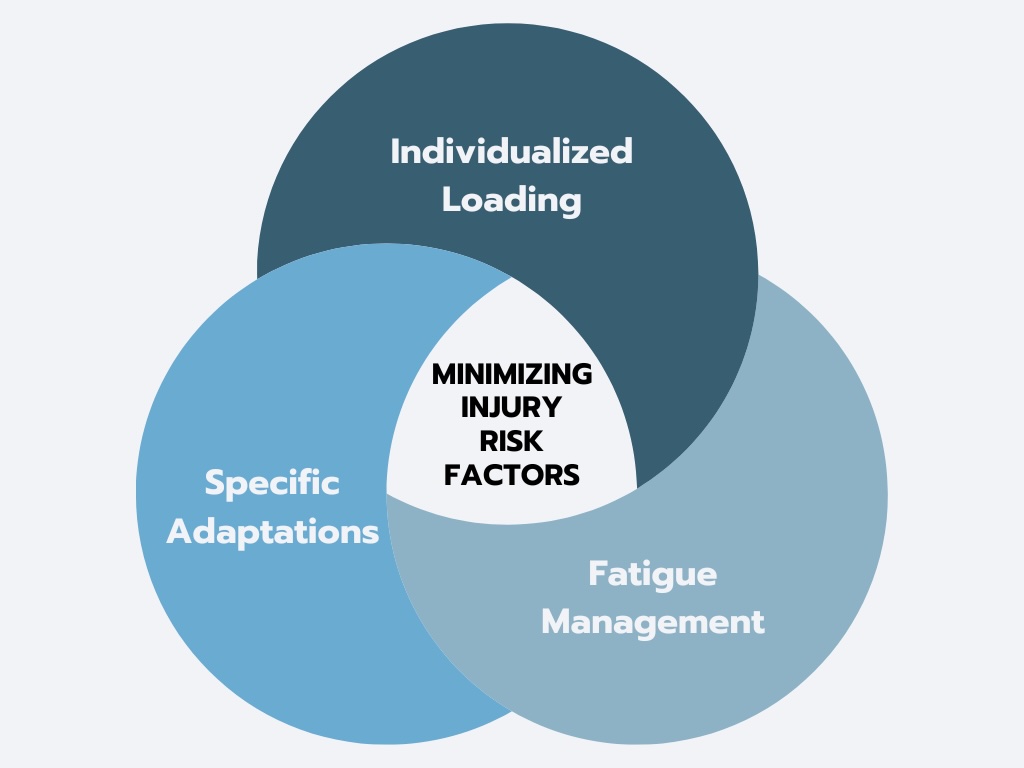
There are three essential keys to VBT when it comes to injury risk minimization:
- Individualized load prescription.
- Fatigue and recovery monitoring.
- Targeted neuromuscular adaptations.
1. Individualized Load Prescription
Precise loading suggestions are a huge benefit of using VBT. Unlike percentage-based programs or perceived effort tracking, the feedback from the lifting data is objective and unique to the athlete. This moves the needle for us in terms of injury risk reduction because appropriate loading of lifts leads to proficient execution with less compensatory movement.
Rapid increase in load and weakness are two major contributors to the risk factors of tendon injuries & muscle strains. Using VBT to prescribe individualized loads can directly influence these factors. Share on XIf we revisit the risk factors of tendon injuries and muscle strains, rapid increase in load and weakness are two major contributors. By using VBT to prescribe individualized loads, we can directly influence these factors.
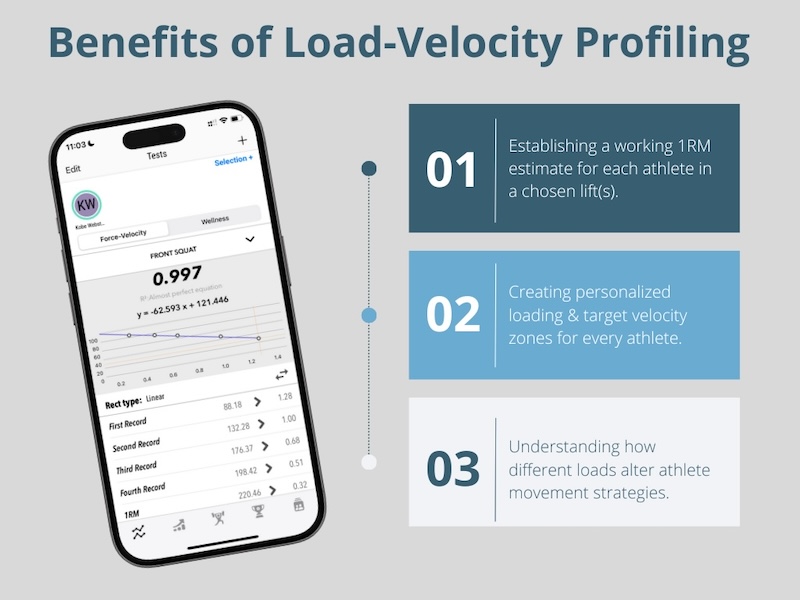
One helpful tool for load prescription is a load-velocity profile. I use the standard L/V profile protocol built into the Vitruve app; however, there are external spreadsheets that coaches can use as well.
An L/V profile provides a baseline for each athlete in terms of what loads are associated with what velocity ranges in any given lift. This method can also predict a pretty accurate 1RM, which gives coaches the option to utilize that for prescribing load as well throughout a program.
An L/V profile requires the athlete to perform 4–5 sets of 1–5 reps at increasingly heavier loads. These reps illustrate the inverse relationship between load and velocity, making it a unique profile for each athlete that can help coaches understand what qualities an athlete may need to enhance.
Most importantly, the L/V profile establishes a baseline of bar speeds at various loads—and how the athlete’s movement looks at each load. This is what can help with the loading prescription most because, based on that data, coaches can program sets for either target bar speeds or target loads and appropriately assign volumes for those sets that are in line with the athlete’s current ability.
Using this method to expose the athlete to progressive overload throughout a program checks two important boxes for us with respect to injury risk.
- Progressive: Assures us that athletes are NOT experiencing a rapid spike in weight room-related loads that would cause tendon pain or dysfunction.
- Overload: Assures us that athletes ARE developing strength over time, helping them adapt to training.
Can you do this without VBT?
Sure. Lifters did it for decades.
But can you precisely and objectively quantify the training and manage the data without VBT?
NOPE.
2. Fatigue and Recovery Monitoring
Another thing you can precisely and objectively quantify with VBT is fatigue level. Not only can we use VBT to look at readiness to train, but on a micro level, we can also look at intra-set fatigue.
Being able to control the micro helps influence the macro. In other words, monitoring fatigue daily can help reduce the over-accumulation of fatigue over the course of a program.
Again, in all of the injury risks we identified, fatigue was repeatedly a factor. Very rarely have we seen basketball players suffer non-contact injuries at the beginning of a game or practice: that is when we are most primed for performance, and fatigue is at a low level.
It’s usually in those ugly fourth quarters or toward the end of a tough practice when we see these unfortunate injuries.
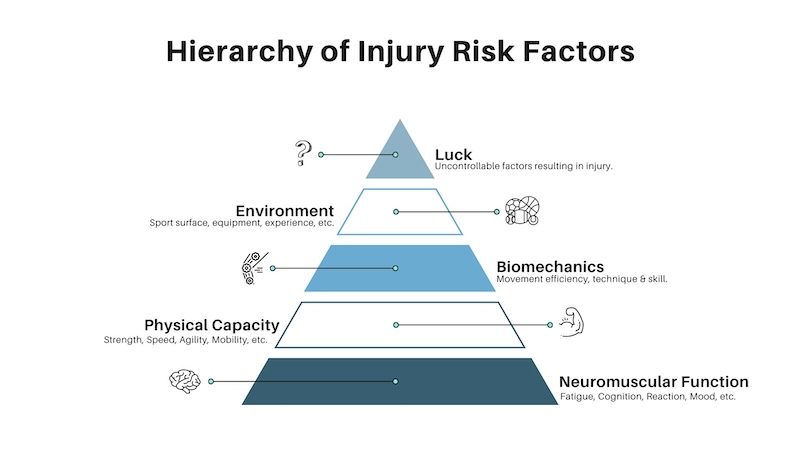
At the micro level, one of the most impactful tools built into the Vitruve app is the intra-set fatigue monitor. Velocity loss during a set is an objective way to measure fatigue, and we know from research that more is not always better.
Training to failure was once believed to be the best way to get stronger—then, the threshold changed to at-or-near failure. Now that we have tools like Vitruve and other VBT devices to help us actually quantify velocity loss, the studies show that failure may occur around 30%–40% velocity loss—the drop-off between the first rep and the worst rep.
Thanks to the work of Pareja-Blanco in 2016, it is clear that outside of pure hypertrophy, there is no benefit of training at 40% velocity loss. When studied against a 20% velocity loss group over an eight-week program, the 20% group had similar strength gains, better sprint gains, and better jump gains and did so with 40% less volume over the course of the study.
Better results with less volume, less fatigue, and less risk of injury? Sounds like an absolute no-brainer to me.
Whether it’s built into the app or needs to be monitored manually by a coach or athlete, the velocity loss within a set is a critical metric when it comes to fatigue management with athletes. Share on XSo, whether it’s built into the app or needs to be monitored manually by a coach or athlete, the velocity loss within a set is a critical metric to pay attention to when it comes to fatigue management with athletes—which, in turn, can aid us in reducing other injury risk factors that are related to fatigue.
Some helpful ways that I’ve implemented this concept into my program include:
- Using Vitruve’s built-in feature to alert the athlete when they’ve reached a 20% velocity loss. The app will flash red and make a loud noise, reminding the athlete what we have already discussed about velocity loss. No matter what, the next rep will be the last rep of that set.
- Assigning velocity-loss cut-off sets. Instead of assigned reps, we estimate and assign the best load for a rep range and target bar speeds for those reps, and instruct the athlete to perform as many reps as possible until they hit 20% or more in velocity loss—then stop the set.
- The above concepts are more strength-based; I assign a 10% velocity loss for power- or speed-based work. This helps keep the reps very powerful and fast, with high bar speeds, and even further reduces fatigue accumulation during more neurologically taxing lift selections.
- And lastly, looking at the average velocity of a set as a whole and comparing it to the previous set(s). If the previous set has a 0%–5% velocity loss, that means we can adjust the weight to go heavier. If the previous set has a 5%–15% velocity loss, we can experiment with an increase in load but also stay put. If the previous set has a 15+% velocity loss, we’ll stay at that weight and emphasize that metric for the next set before either reducing the total remaining volume or adjusting the load to be lighter.
All of these strategies can be instrumental in controlling the day-to-day fatigue of our athletes. Not to mention, some athletes may need to be even more conservatively managed due to their schedule for the rest of that day. Maybe they have practice later, or a workout, or even a game—those velocity loss thresholds would become even stricter and more precise to make sure that we don’t interfere with game performances due to fatigue.
Another important consideration when it comes to injury risk management and fatigue management is that many of these injuries are incorrectly viewed as a biomechanical issue rather than a neuromuscular one.
Another important consideration when it comes to injury risk and fatigue management is that many injuries are incorrectly viewed as a biomechanical issue rather than a neuromuscular one. Share on XAs coaches, we’re quick to think that we always have the lift, drill, or program that can help avoid these injuries by enhancing the athlete’s structural integrity. And don’t get me wrong, that resiliency plays a huge role. But a lot of these injuries are not happening due to biomechanics.
Let’s take a non-contact ankle sprain, for example. The inversion moment of the sprain can happen as fast as 50 milliseconds. Even if we work on ankle function relentlessly, there’s nothing we can do in the weight room that is that fast. An extremely quick plyometric happens at 150 milliseconds. An elite-level sprint ground contact happens at around 90 milliseconds.
So, what can operate at speeds as fast as 50 milliseconds? Our brain. Our neuromuscular system.
This illustrates the neurological nature of some of these injuries, which showcases the importance of fatigue management. Of course, sprints, plyos, and lifting are crucial, but these alone cannot reduce the risk of injury.
Less fatigue can lead to a better performance from our neuromuscular system—more optimal and efficient “firing” patterns of our muscles. This neurological efficiency can lead to better usage of our structural system.
Therefore, while physical exercise is a non-negotiable component of injury risk reduction, we also need to make sure that our athletes can actually reap the benefits of their physical efforts.
“Robbing Peter to pay Paul” means to discharge one debt only to incur another. A lot of times that is what we unintentionally do in training. We train so hard to enhance the physical qualities needed to meet the demands of the sport, only to rob the neuromuscular system of its function and efficiency in the process.
Using VBT to help measure and manage fatigue can help us walk this fine line of training extremely hard but also recovering adequately, giving our athletes the best chance to perform at their best when they are under the most stress.
3. Targeted Neuromuscular Adaptations
Another great feature of VBT is the ability to chase specific adaptations with real-time feedback. This goes hand-in-hand with the previous two features discussed: we can prescribe specific loads at specific target bar speeds in an effort to unlock specific adaptations as a result of the lift.
This is great for training in general, but I want to zoom in a little bit on a specific scenario as it relates to the topic of injury prevention—return to play.
We know that a huge risk factor in injury is having a previous injury. So, if an injury occurs, it is even more critical to properly rehab and return to play with precision. If we can help the athlete restore function, we can potentially reduce the risk factors of re-injury.
Hindsight being 20-20, we can look at the Kevin Durant Achilles tear as an example of this. Earlier in that playoff series, he suffered a calf strain.
Potentially, that had an influence on his Achilles injury. Ultimately, he was one of the best players in the world on the biggest stage, so keeping him off the court would have been next to impossible—but that is the risk I’m sure he was notified of and completely willing to take to win a championship.
I know a large number of physical therapists, coaches, and practitioners who are now using VBT as a staple in their programs because of the valuable feedback given within each session. This can help both the performance and medical staff compare current performance with previous data (especially if they’ve used VBT in the past) to paint a clearer picture of where that athlete is in their recovery process.
VBT can help both the performance and medical staff compare current performance with previous data to paint a clearer picture of where that athlete is in their recovery process. Share on XEven further, coaches and practitioners can start to compare metrics from an injured to a non-injured side and use that as a benchmark of recovery. Metrics like velocity, power, or range of motion can be extremely useful when looking at the effectiveness of an athlete’s rehab and strength program on their way back from injury.
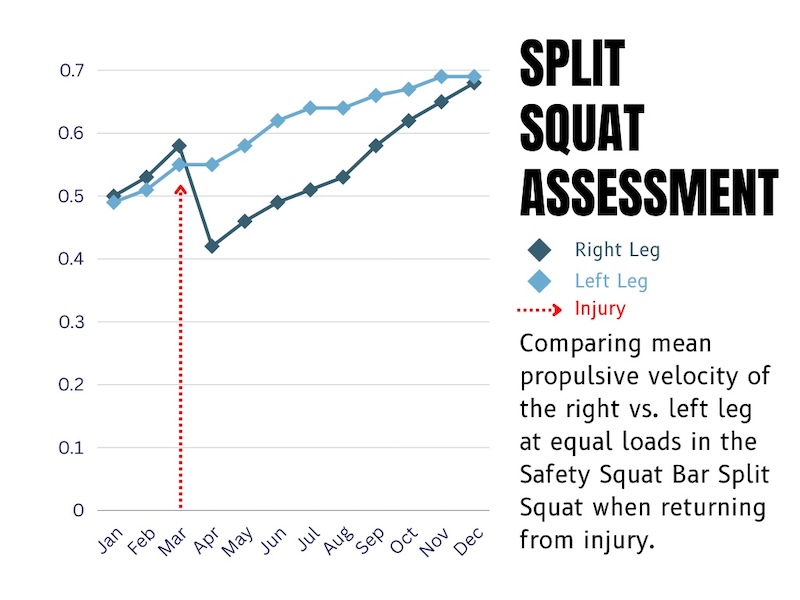
Let’s take that same example of a right ankle sprain and put it into context. Using VBT to track this athlete performing a split squat, you notice that the left leg averages .65 m/s over a set of five reps, and the right leg averages .45 m/s over a set of five reps. Same weight, same reps, much different execution.
The athlete is telling you they’re good to go and feel ready to play. Of course, they are—athletes love to play. They’re tough. They want to compete.
Maybe their ROM tests even come back normal, and they look good when they move.
But you look at this VBT data and can undoubtedly say that there is a strength discrepancy on that right leg. Now, you can have further discussions or conduct further testing to see if additional interventions may be needed to help get the athlete back on the court.
I’m not saying you need to shut every athlete down until they’re completely symmetrical (good luck) or protect every athlete like a delicate little flower, but at least having this information accessible gives you the best chance to put them in situations to succeed.
If it’s the playoffs, maybe it’s “Tape it up and go get us a win.” If it’s the pre-season, perhaps it’s “Let’s take tonight off and do some extra rehab to get ready for next week.” The VBT data doesn’t force us to make any decisions; it just helps us make the most informed one.
To bring it all back together, we know for a fact that injuries cannot be 100% predicted or 100% prevented. However, we can identify risk factors that are more predictable and preventable and try to influence those factors with training.
Introducing a training aid, such as VBT, to help monitor and measure those efforts has shown to be well worth the investment in both time and resources. The more we know, the more we can help.
Since you’re here…
…we have a small favor to ask. More people are reading SimpliFaster than ever, and each week we bring you compelling content from coaches, sport scientists, and physiotherapists who are devoted to building better athletes. Please take a moment to share the articles on social media, engage the authors with questions and comments below, and link to articles when appropriate if you have a blog or participate on forums of related topics. — SF

